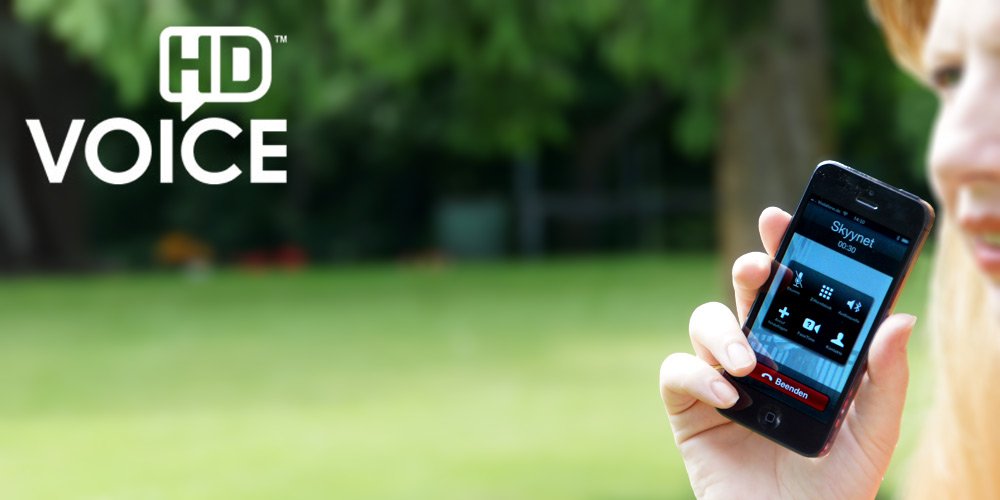HD Voice

Analogue
As the telephone was invented in 1881 voice quality was no topic, yet. With only 3,4 kHz the calls were transmitted and sounded accordingly. Since the end of World War II the quality did not changed for a long time. With the invention of ISDN in 1994 8 kHz were possible.
Digital
With VoIP the telephone network was changed
into a packet based standard. Since that time different voice qualities are possible while the codec
G.711 with its unchanged 8 kHz still remained the default.
In GSM the standard Full Rate with 8 kHz and 13 kBit/s existed.
As an alternative to enhance battery life one could even use Half Rate with only 5,6
kBit/s. Since 1995 Enhanced Full Rate with 8 kHz and 12,2 kBit/s was the standard of voice
transmission in GSM mobile communication. Beginning in 1999 this was
superseded by Advanced Multi-Rate which still operates at 8 kHz but only consumes between
4,75 and 12,2 kBit/s.
Digital networks and modern telephones could support a significant better voice quality. As the used voice transmission quality is negotiated between the devices for VoIP older phones' limitations do not have to be considered which only support the G.711 codec.
 Since 2009 HD Voice
established itself. In VoIP-networks G.722 with a data rate of 64 kBit/s
is the widest spread standard. VoIP-router and wireless phones using the
CAT-iq-standard do support it. In cellular networks Adaptive Multi-Rate Wideband (AMR-WB) is in use
with its codec G.722.2. The only thing in common with G.722 is its transferred pitch range apart
from the similar name. The codec is optimzed for the operating conditions in cellular networks and
highly compresses the voice. The needed transmission band width is variabel and between 6,6 and 24
kBit/s. In lulls of conversation only the so called silence descriptor is transferred and the rate
can decline as low as 1,75 kBit/s. G.722 on the other hand constantly needs 64 kBit/s transmission
band width. The quality of AMR-WB is up to 7 kHz.
Since 2009 HD Voice
established itself. In VoIP-networks G.722 with a data rate of 64 kBit/s
is the widest spread standard. VoIP-router and wireless phones using the
CAT-iq-standard do support it. In cellular networks Adaptive Multi-Rate Wideband (AMR-WB) is in use
with its codec G.722.2. The only thing in common with G.722 is its transferred pitch range apart
from the similar name. The codec is optimzed for the operating conditions in cellular networks and
highly compresses the voice. The needed transmission band width is variabel and between 6,6 and 24
kBit/s. In lulls of conversation only the so called silence descriptor is transferred and the rate
can decline as low as 1,75 kBit/s. G.722 on the other hand constantly needs 64 kBit/s transmission
band width. The quality of AMR-WB is up to 7 kHz.
Deutsche Telekom supports AMR-WB in their UMTS network since 2011 and advertizes HD Voice in their VoIP network, too. Gateways between AMR-WB in the cellular network and G.722 in the fixed line network exists since 2013 and support high quality calls. Vodafone supports AMR-WB since 2013 and Telefónica since 2015.
Cellular Networks
There is no guarantee for HD Voice connections. Based on the
used mobile phones, base stations and telephone switches, the quality of the radio contact and the
degree of capacity in the cell different codecs with different audio qualities are used with data
rates between 5,6 and 24 kBit/s. If one of the conversational partners switches from UMTS to GSM during the call a fallback to normal
voice quality might occur. AMR-WB is also deployable in GSM networks which all German providers support.
The LTE network was initially not used for telephony. As it's an All-IP-Network calls have to be transmitted via VoIP. This is then called VoLTE. If the call is placed between differend cellular network operators there has to be no conversion between codecs but the call has to be passed. Unlike the TDM interface used in GSM and UMTS networks which by definition only supports G.711 an VoIP-interconnection is which supports the negotiated of codecs across network boundaries. All three German network providers announced in Spring 2015 to support VoLTE. But keep in mind that the mobile phones have to support this feature, too.
Fixed Line
Wireless phones modulate between analogue and digital in the handset. Usually they use the compressing codec G.726 to use only little bandwidth. With the standard CAT-iq they also have to support HD Voice. The codec G.722 is used therefor which could be used without code coversion if all decices on the way would support that codec. HD Voice audio devices are a lot less common in the fixed line market than in the mobile market. While they are comparably cheaper than mobile phones they are used longer due to the little innovation. Often they are used until they are broken. To motivate a customer to buy a new fixed line phone before the old one is broken it has to offer a significant added value.
Enhanced Voice Services
The next step of audio quality in cellular networks is the codec Enhanced Voice Services. It supports a frequency range up to 20 kHz and may be used in LTE networks with VoLTE or WiFi Calling and supported devices. Vodafone Germany markets this in their cellular network as Crystal Clear, Deutsche Telekom calls it HD Voice Plus and Telefónica Deutschland Full-HD-Voice.



